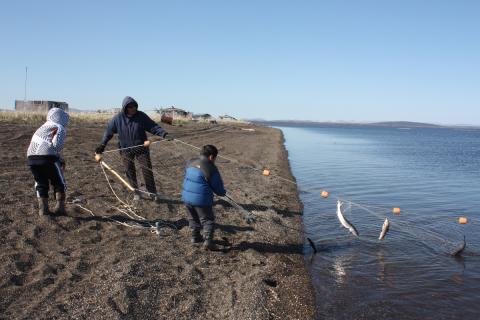
The Issue
The Arctic is experiencing pronounced environmental changes with significant implications for Indigenous peoples who rely heavily on wild game, fish, and other resources. Decreasing sea ice, thinning lake and river ice, thawing permafrost, thaw slumps, erosion, storm surges, unpredictable weather, inland drying, shifting ranges and abundance of resources, and the potential for increased commercial fisheries development all pose challenges for traditional hunting and fishing livelihoods.
Why it Matters
Traditional hunting and fishing ways of life are the cultural and economic lifeblood of Arctic communities. In the U.S. Arctic, communities harvest over 400 pounds of wild foods per person per year. Far more than just a food source, subsistence practices for Arctic Indigenous peoples form the basis of rural economies, culture, identity, spirituality, health and wellbeing. Current and projected environmental and linked social changes threaten the integrity of these systems.
State of Knowledge

Climate change is affecting the important subsistence fishes and fisheries in the Arctic. Environment shifts are likely to present more favorable conditions for some species and threaten others, but holistic impacts on the Arctic ecosystem are not easily predictable because of its complexity and annual variability. Some important subsistence fish species, like chars and whitefishes, will likely benefit from climate change. These fish are found in polar and temperate latitudes so can likely adapt to changes and even flourish in more temperate environments. Increases in primary productivity and temperature are likely to increase growth rates of these species; this is already being seen in Arctic char and likely Dolly Varden trout. Additionally, warmer ocean conditions and increases in food sources are predicted to extend the northern range of suitable habitat for other fish species such as Pacific salmon. Along with salmon, other species occupying similar trophic levels may also increase in abundance. Although range expansion by new species may present new subsistence opportunities, new species may also lead to increased competition for favorable food sources such as zooplankton, and may deleteriously affect traditional subsistence species. Other fishes, like Arctic cod, are being negatively affected by increased temperature, changes in water mass structure and reduced ice, which is important for survival of many Arctic species.
Climate change is also directly impacting subsistence practices. Physical environmental change – such as shallower river water and drying lakes, thawing permafrost and increasing erosion, unpredictable ice thickness, new freeze-thaw cycles – affects infrastructure, access to, and processing of important fish species. For example, unpredictable ice conditions hinder, and at times exclude, safe travel. Erosion caused by thawing permafrost and increased storm surges threatens villages, fish, and hunting camps. Lower river and lake water levels provide challenging conditions for boat access. Less predictable fish movements challenge seasonal harvesting practices. Warmer spring weather causes unfavorable fishing conditions. Warmer, wetter weather causes traditionally dried fish to spoil. New freeze-thaw cycles challenges traditional fermentation.
These shifts all interact with rapid changes in the social and economic systems of Arctic communities to create a total environment of change in the Arctic. For example, lower water levels combined with recent trends of fewer young people learning about their local waterways increases risk of equipment damage and personal injury during subsistence practices. The increasing costs of fuel and gear interact with unpredictable fish movements and increased wage employment to narrow the window of availability for seasonal migrations to harvest preferred resources.
Where the Science is Headed
Recent scientific advances in our understanding of Arctic fishes have tended to focus on species like Arctic gadids and other demersal fishes that are not typically caught in subsistence fisheries. The impact of climate change on vital Arctic subsistence species, such as whitefishes, is currently being investigated and more research is needed to understand current and likely future impacts. Increasingly, scientists are developing new understanding of the Arctic through their research and through close collaborations with local people. Collectively, we are building relationships and elevating the importance of the co-production of knowledge about natural resources and responses to the changing environment; these research partnerships are vital for sustainable and equitable management of fisheries and other natural resources.
Key References
- Craig, P. C. 1987. Subsistence fisheries at coastal villages in the Alaskan Arctic, 1970–1986. Technical report 129. United States Department of the Interior Minerals Management Service.
- Harwood, L.A., Smith, T.G., George, J.C., Sandstrom, S.J., Walkusz, W., and Divoky, G.J. 2015.Change in the Beaufort Sea ecosystem: Diverging trends in body condition and/or production in five marine vertebrate species. Progress in Oceanography 136:263–273.
- Georgette, S., and A. Shiedt. 2005. Whitefish: traditional ecological knowledge and subsistence fishing in the Kotzebue Sound region, Alaska. Alaska Department of Fish and Game, Division of Subsistence, Technical Paper Number 290, Kotzebue.
- Moerlein, K. and C. Carothers. 2012. Total environment of change: impacts of climate change and social transitions on subsistence fisheries in Northwest Alaska. Ecology & Society. http://www.ecologyandsociety.org/vol17/iss1/art10/
- Nielson, J. L., G. T. Ruggerone, and C. E. Zimmerman. 2013. Adaptive strategies and life history characteristics in a warming climate: Salmon in the Arctic? Environmental Biology of Fishes 96: 1187-1226.
- Reist, J. D., F. J. Wrona, T. D. Prowse, M. Power, J. B. Dempson, J.R. King, and R. J. Beamish. An overview of effects of climate change on selected Arctic freshwater and anadromous Fishes. AMBIO: A Journal of the Human Environment 2006 35 (7), 381-387.
- Wassmann, P. C.M. Duarte, S. Agusti, and M.K. Sejr. 2011. Footprints of climate change in the Arctic marine ecosystem. Global Change Biology 17(2): 1235-1249.
Contacts for further Information
Courtney Carothers, University of Alaska Fairbanks
clcarothers [at] alaska.edu
Andrew Seitz, University of Alaska Fairbanks
acseitz [at] alaska.edu
Trent Sutton, University of Alaska Fairbanks
tmsutton [at] alaska.edu
| Attachment | Size |
|---|---|
| aa015_july_2018_subsistence_fisheries_v2.pdf191.04 KB | 191.04 KB |
